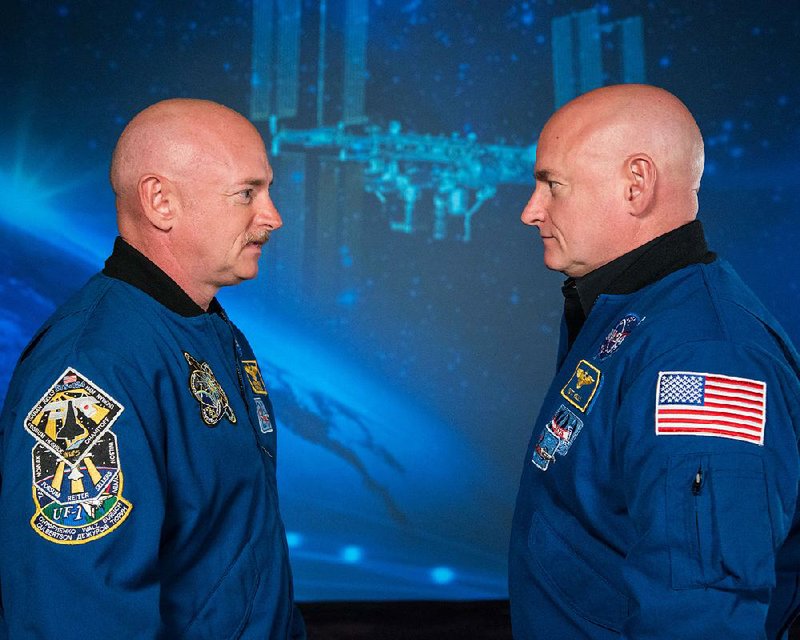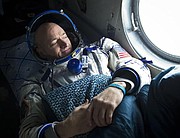For 340 days, Scott Kelly circled the Earth aboard the International Space Station, gathering data about himself.
He drew blood from his arms. He saved his urine. He played computer games to test his memory and reaction speed. He measured the shape of his eyes.
Two hundred and forty miles below, Scott's twin brother, Mark, who also served as an astronaut, carried out identical tests. Now, a comparison of these two men has provided a unique opportunity to learn what happens to the human body in space -- down to the molecular level.
On Thursday, just over three years after Scott Kelly, 55, returned to Earth, NASA researchers reported that his body experienced a vast number of changes while in orbit. DNA mutated in some of his cells. His immune system produced a host of new signals. His microbiome gained new species of bacteria.
Many of these biological changes seemed harmless, disappearing after he returned to Earth. But others -- including genetic mutations and, after his return, declines in cognitive test scores -- did not correct themselves, provoking concern among scientists.
Some considered the risks manageable, while others wondered whether it would ever be safe for astronauts to take long journeys to Mars or beyond. Final answers will depend on studies of still more astronauts.
"I believe it's the most comprehensive assessment of human beings to date," said Dr. Eric Topol, director of the Scripps Research Translational Institute, who was not involved in the study. "I don't know that there's been anything close to this."
Although astronauts have been carried aloft for almost six decades, there's much about life in space that scientists still don't understand. With investigations like the NASA Twins Study, published in the journal Science, the agency hopes to get some answers before sending astronauts on longer flights.
By comparing the brothers, NASA hoped to better understand the changes that Scott Kelly experienced during his mission.
"The fact that they're twins really narrows down the alternatives," said Susan Bailey, a cancer biologist at Colorado State University and a co-author of the new study. "We can say that, as best as we can tell, these changes are due to spaceflight."
By many measures, the scientists eventually found, Kelly changed about as much as astronauts who stayed on the space station for only six months. Eventually the pace of biological change slowed, suggesting that perhaps the human body reaches a new equilibrium in space.
But Kelly's body was also altered in some surprising ways.
Bailey studied special sections of his DNA called telomeres, which sit at the end of chromosomes, protecting them from deterioration.
As people age, their telomeres tend to get shorter. Stress -- such as radiation or pollution -- may hasten aging by fraying telomeres even faster than usual.
Strangely, the average length of Kelly's telomeres increased in space, rather than decreasing, as if his cells were becoming more youthful.
Regular exercise and a healthy diet might be part of the reason. But going to space also might have awakened a quiet population of stem cells in Kelly's body, Bailey said.
His cells might not have grown longer telomeres, in other words. Instead, perhaps his body manufactured a new supply of young cells with longer telomeres.
Going to space also appeared to trigger a genetic shift in Kelly. Thousands of genes that were once quiet increased their activity -- genes that remained quiet in Mark Kelly's body back on Earth. The longer Scott Kelly stayed aloft, the greater the number of genes becoming active.
Some of the awakened genes are known to encode proteins that help fix damaged DNA. That would make sense, given that radiation levels in the International Space Station are higher than on Earth.
Christopher Mason, a geneticist at Weill Cornell Medicine in New York, estimated that Kelly was exposed to 48 times more radiation than the average exposure on Earth over the course of a year. His cells might have been busy repairing radiation injury.
A number of other activated genes, however, play roles in the immune system. What exactly triggers those changes isn't clear.
Kelly's return to Earth on March 1, 2016, proved to be one of the biggest moments -- biologically speaking -- of the whole mission. His body showed signs of intense stress, and his immune system was in high gear.
Michael Snyder, a geneticist at Stanford University and co-author of the research, cautioned that this response might not be typical. "Maybe he got a viral infection," he speculated. "This is why you want to see it in more people."
Despite that shock, Kelly's body mostly returned to preflight condition. Some species of bacteria that thrived in his gut while he was in space, for example, became rare again on his landing.
The strange lengthening of Kelly's telomeres disappeared after less than 48 hours on Earth. In fact, Bailey and her colleagues started finding many cells with telomeres that were shorter than before Kelly went to space.
"People have asked me, 'Well, is going to space the fountain of youth?' " Bailey said. "I don't think so. If it is, you're going to have to stay up there forever."
Some aspects of Kelly's biology didn't return to the preflight norm.
Six months after he came back to Earth, 8.7 percent of his genes were still behaving in an altered way. Judging from the small size of this shift, Snyder described the change as modest.
The researchers also found that Kelly didn't do as well on his return on cognitive exams. "He got slower and less accurate on virtually all of the tests," said Dr. Mathias Basner, a cognitive scientist at the University of Pennsylvania.
In his 2017 memoir, Endurance, Kelly describes struggling after his return with pain, sleeping troubles and other woes. One night he felt as if he was "fighting through quicksand," he wrote.
Another enduring change, scientists found, was a collection of genetic mutations that Kelly gained in space. "We see them appear in flight, and then they persisted afterward," Mason said.
Sometimes radiation triggers a type of mutation that makes cells prone to gain still more mutations as they divide. Eventually, the cells may start growing uncontrollably -- "taking steps on the road to cancer," Bailey said.
Peter Campbell, a cancer biologist at the Wellcome Sanger Institute in Britain who was not involved in the new study, said scientists can't predict what the extra mutations will mean for Kelly's health.
"It is hard to be sure, but I believe those sorts of numbers would be associated with a moderate increase in cancer risk," he said.
These two lingering changes -- in Kelly's cognition and DNA -- left a number of experts concerned about the risks of a trip to Mars, which could take a year.
Gary Strangman, a psychologist at Harvard Medical School, said a decrease in speed and accuracy "could potentially have serious consequences on long-duration missions."
Topol, of the Scripps Institute, found the implications of Kelly's experience to be grim.
"The main conclusion I got from this paper, based on all the objective data, is why would anybody want to go to Mars or be in space?" he said. "Because this is really scary."
Jerry Shay, a cell biologist at the University of Texas Southwestern Medical Center, was much more optimistic. He held out hope for countermeasures that would protect astronauts.
Already he and his colleagues, for example, are testing drugs to trigger cells to fix DNA damaged by radiation. "I think all these problems are solvable," Shay said.
NASA has begun sifting all these results to help plan the next round of missions to the International Space Station.
"It won't be a replication of what you saw in the Twins Study," said Jennifer Fogarty, chief scientist at NASA's Human Research Program.
"We're going to learn from that, and we're going to be smarter about the questions we ask. There's a lot of fascinating stuff to go measure. It's just not clear what it means."
A Section on 04/12/2019

